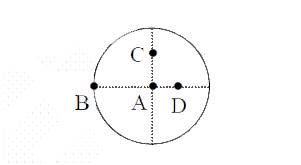A round disc of moment of inertia I2 about its axis perpendicular to its plane and passing through its centre is placed over another disc of moment of inertia I1 rotating with an angular velocity ω about the same axis. The final angular velocity of the combination of discs is.
ω
I1ωI1+I2
(I1+I2)ωI1
I2ωI1+I2
The correct Answer is:B
To solve the problem, we need to apply the principle of conservation of angular momentum. Here’s a step-by-step solution:
Step 1: Understand the System
We have two discs:
- Disc 1 with moment of inertia I1 rotating with an angular velocity ω.
- Disc 2 with moment of inertia I2 which is initially at rest (angular velocity = 0).
Step 2: Calculate Initial Angular Momentum
The initial angular momentum Li of the system can be calculated as follows:
Li=I1⋅ω+I2⋅0=I1⋅ω
Thus, the initial angular momentum is simply I1⋅ω.
Step 3: Calculate Final Angular Momentum
After the two discs are combined, they will rotate together with a new angular velocity ω′. The final angular momentum Lf of the system is given by:
Lf=(I1+I2)⋅ω′
Step 4: Apply Conservation of Angular Momentum
According to the conservation of angular momentum, the initial angular momentum must equal the final angular momentum:
Li=Lf
Substituting the expressions we derived:
I1⋅ω=(I1+I2)⋅ω′
Step 5: Solve for Final Angular Velocity
To find the final angular velocity ω′, we rearrange the equation:
ω′=I1⋅ωI1+I2
Conclusion
The final angular velocity of the combination of the discs is:
ω′=I1⋅ωI1+I2
We have two discs:
- Disc 1 with moment of inertia I1 rotating with an angular velocity ω.
- Disc 2 with moment of inertia I2 which is initially at rest (angular velocity = 0).
The initial angular momentum Li of the system can be calculated as follows:
Li=I1⋅ω+I2⋅0=I1⋅ω
Thus, the initial angular momentum is simply I1⋅ω.
After the two discs are combined, they will rotate together with a new angular velocity ω′. The final angular momentum Lf of the system is given by:
Lf=(I1+I2)⋅ω′
According to the conservation of angular momentum, the initial angular momentum must equal the final angular momentum:
Li=Lf
Substituting the expressions we derived:
I1⋅ω=(I1+I2)⋅ω′
To find the final angular velocity ω′, we rearrange the equation:
ω′=I1⋅ωI1+I2
The final angular velocity of the combination of the discs is:
ω′=I1⋅ωI1+I2
Similar Questions
The moment of inertia of a copper disc, rotating about an axis passing through its centre and perpendicular to its plane
View SolutionA charge Q is uniformly distributed over the surface of non - conducting disc of radius R. The disc rotates about an axis perpendicular to its plane and passing through its centre with an angular to its plane and passing through its centre of the disc. If we keep both the amount of charge placed on the disc and its angular velocity to be constant and vary the radius of the disc then the variation of the magnetic induction at the centre of the disc will br represented by the figure:
View SolutionThe moment of inertia of a uniform circular disc is maximum about an axis perpendicular to the disc and passing through -

View SolutionIf I1 is the moment of inertia of a thin rod about an axis perpendicular to its length and passing through its centre of mass and I2 is the moment of inertia of the ring about an axis perpendicular to plane of ring and passing through its centre formed by bending the rod, then
View SolutionCircular disc of mass 2 kg and radius 1 m is rotating about an axis perpendicular to its plane and passing through its centre of mass with a rotational kinetic energy of 8 J. The angular momentum is (Js) is
View SolutionThe moment of inertia of a uniform ring about an axis passing through its centre and perpendicular to its plane is 100kgm2. What is the moment of inertia of the ring about its diameter ?
View SolutionThe moment of inertia of a uniform ring about an axis passing through its centre and perpendicular to its plane is 100kgm2. What is the moment of inertia of the ring about its diameter ?
View SolutionMoment of inertia of a disc about an axis which is tangent and parallel to its plane is I . Then the moment of inertia of disc about a tangent, but perpendicular to its plane will be
View SolutionA disc of the moment of inertia 'l1' is rotating in horizontal plane about an axis passing through a centre and perpendicular to its plane with constant angular speed 'ω1' . Another disc of moment of inertia 'I2'. having zero angular speed is placed discs are rotating disc. Now, both the discs are rotating with constant angular speed 'ω2'. The energy lost by the initial rotating disc is
View SolutionMoment of inertia of a uniform quarter disc of radius R and mass M about an axis through its centre of mass and perpendicular to its plane is :
View Solution
